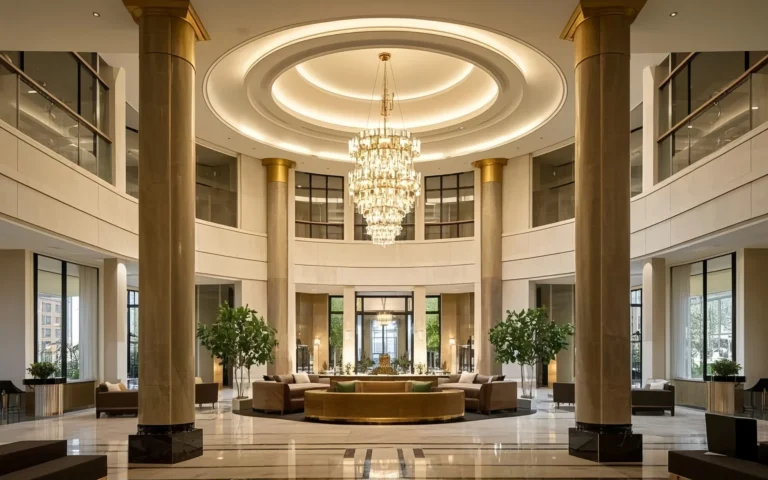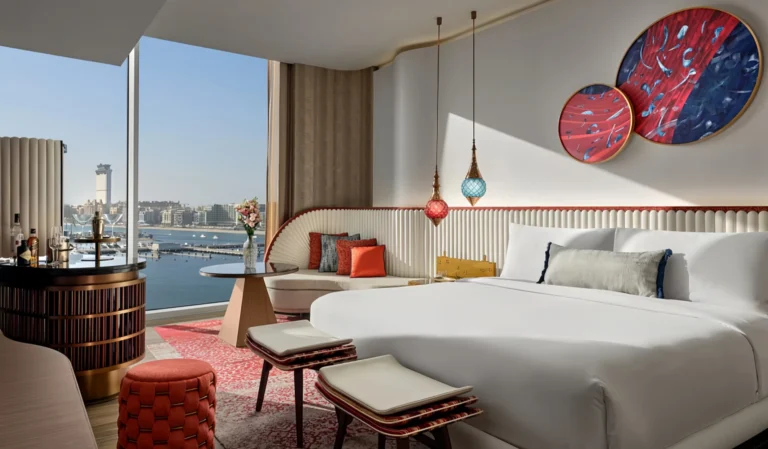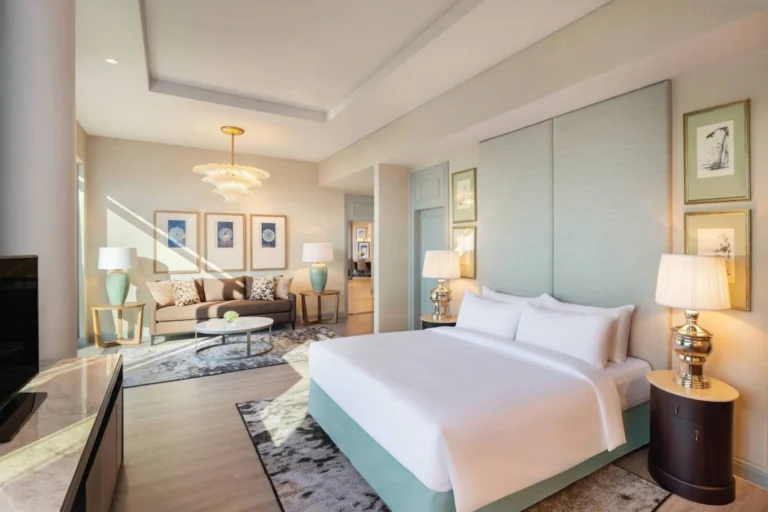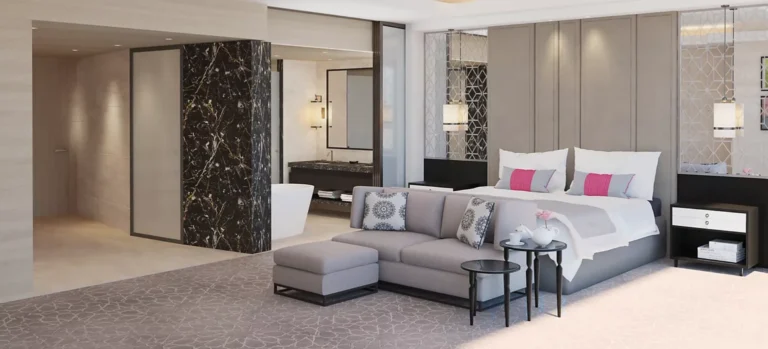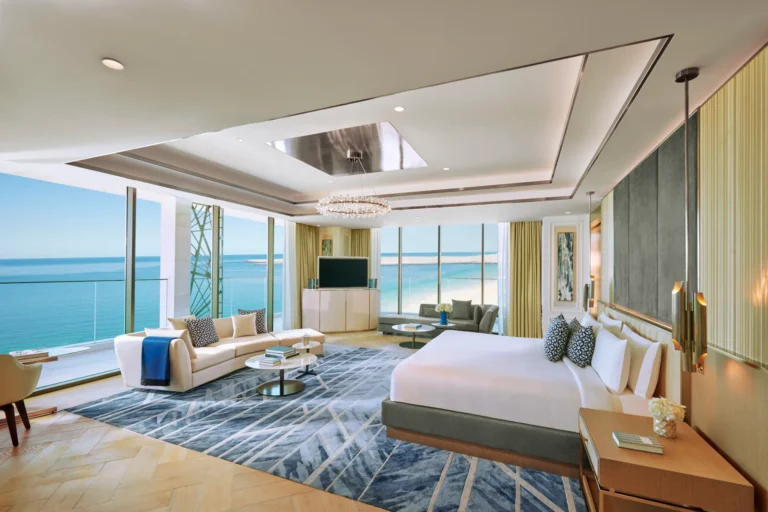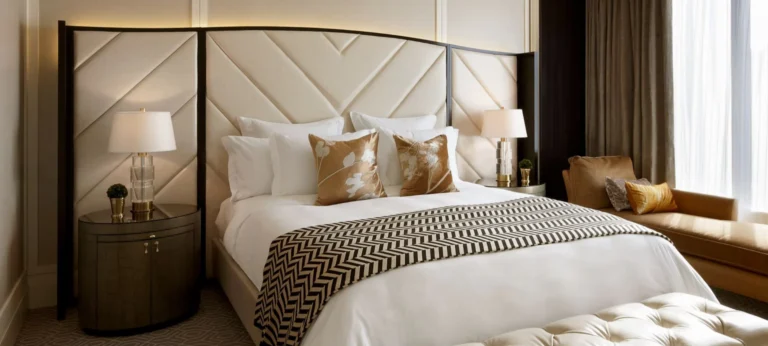In this guide, we’ll walk you through how to plan and design hotel guest room furniture the right way in 2026 — from understanding layout and space efficiency to choosing the right furniture pieces, styles, and materials. You’ll also discover the latest trends, practical design ideas, and real solutions for different room types (small rooms, boutique concepts, luxury suites, and business hotels).
We’ll compare ready-made vs. custom furniture, show you where hotels actually buy their furniture, and share how to choose reliable suppliers or manufacturers without wasting budget.
By the end, you’ll have a clear, actionable framework to create guest rooms that look beautiful, feel comfortable, function efficiently, and align with your brand — just like the best hotels in the world.
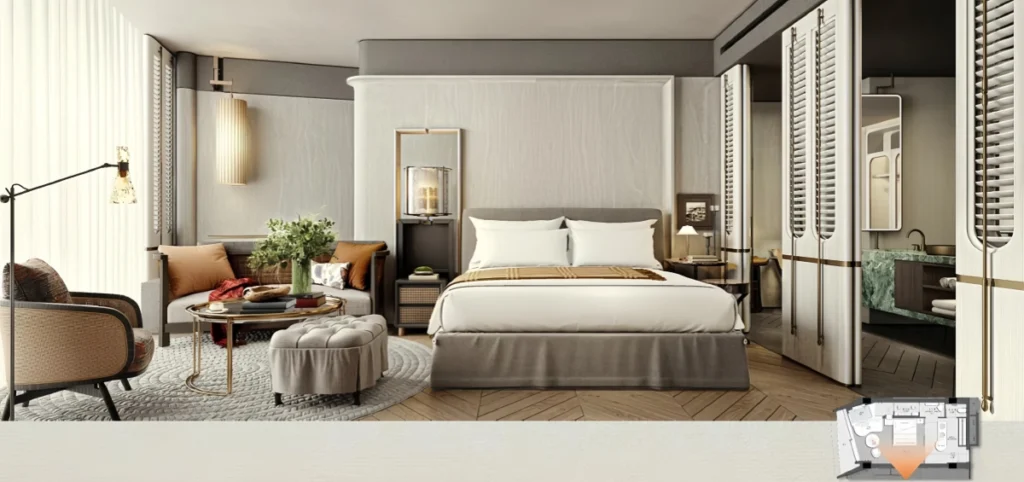
Core Principles of Hotel Guest Room Furniture Design in 2026
Great hotel guest room design doesn’t start with choosing a bed or a nightstand—it starts with strategy. In 2026, the most successful hotels follow a few core principles that ensure every piece of furniture serves a purpose, enhances the guest experience, and reflects the brand.
Here are the key foundations you must consider before selecting any furniture:
Start with the Guest Experience (Function First)
Every guest interacts with the room differently—some work, some relax, some simply rest. The best guest room furniture design anticipates all these behaviors and supports them seamlessly. From bed height and mattress comfort to lighting placement and desk usability, every detail contributes to a smooth, intuitive stay. A beautiful room fails if it doesn’t function naturally.
- Bed height and comfort matter more than ever
- Nightstands need outlets and storage
- Desks should be functional and space-saving
- Seating should work for both relaxing and working
Plan the Layout Before Choosing Furniture
Space defines comfort. Even the most stylish furniture can make a room feel crowded if the layout isn’t planned with movement in mind. Good design ensures clear pathways, logical furniture placement, and balance between open space and privacy. Smart space planning makes even small guest rooms feel generous and well-composed.
- Leave clear pathways (bed → bathroom → entry)
- Position furniture so guests don’t bump into corners
- Allow space for luggage and storage
- Think about different room sizes (small, standard, suite)
Balance Comfort, Aesthetics & Durability
Guest room furniture must be built to last yet feel welcoming from the first touch. In 2026, “residential comfort with hospitality strength” has become the new norm—furniture that looks elegant but withstands daily use from hundreds of guests. The ideal balance lies in timeless design, sturdy materials, and ergonomic comfort that invites guests to linger.
- Supportive mattresses and ergonomic seating
- Durable frames and fabrics (stain-resistant, scratch-resistant)
- Timeless design that won’t look outdated in 2 years
Design with Brand Identity in Mind
Furniture is the silent ambassador of your brand. Whether it’s a minimalist business hotel or an art-driven boutique property, every piece should tell a consistent story through materials, shapes, and finishes. Guests should feel the brand’s essence the moment they step inside, even before they see the logo.
- Luxury hotel → premium materials, elegant shapes
- Boutique hotel → unique, creative, local craftsmanship
- Business hotel → smart, minimal, efficient
- Resort → natural textures, relaxed comfort
Maximize Flexibility & Future-Proofing
Hotels evolve, and so should their furniture. Modular pieces, multi-functional units, and smart technology integration make it easier to adapt to new guest needs or room configurations. Investing in flexible design ensures longevity, reduces renovation costs, and keeps the space relevant for years to come.
- Modular furniture (easy to reconfigure)
- Multi-functional pieces (bench = luggage rack + seating)
- Built-in storage to reduce clutter
- Smart furniture with integrated power/tech
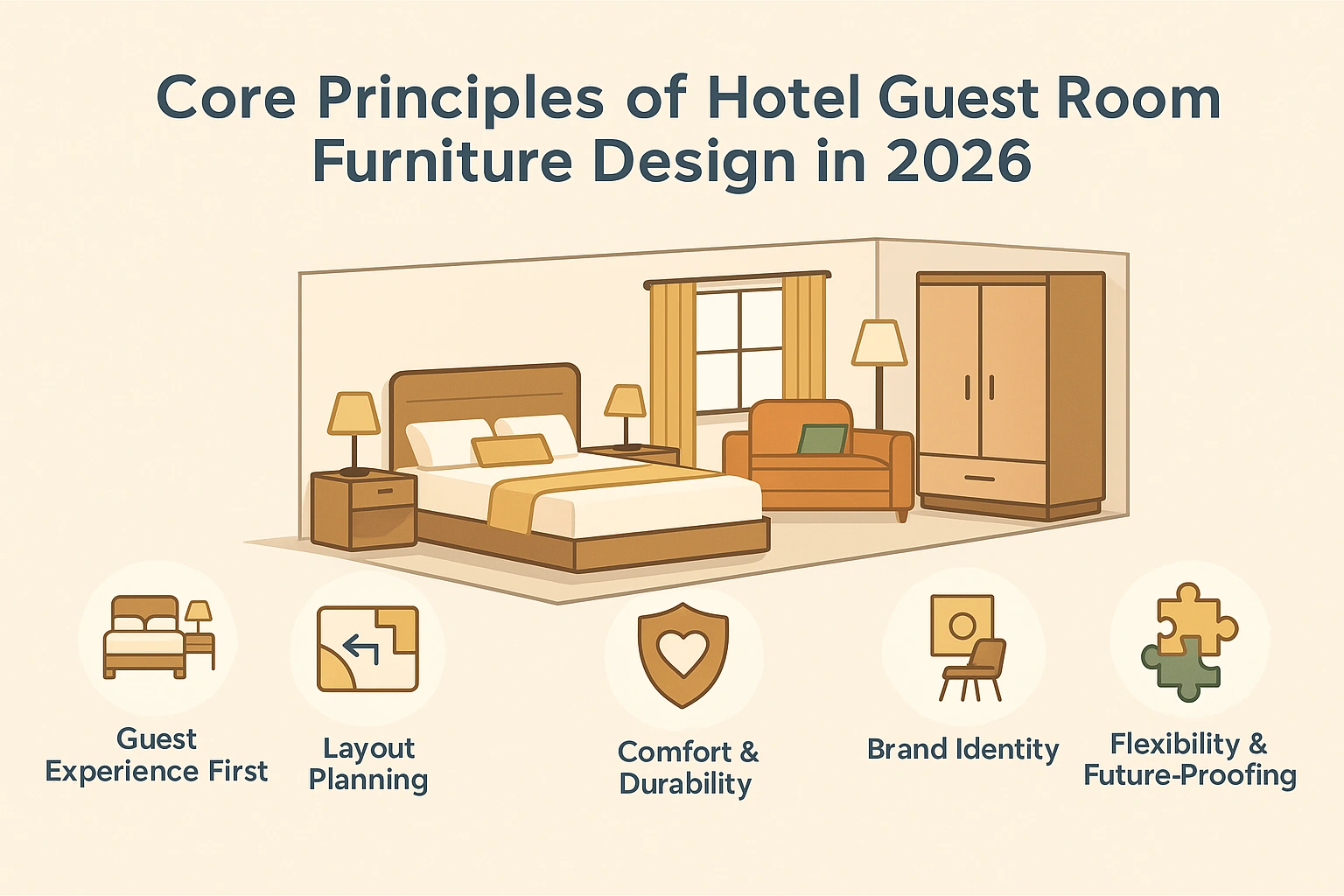
Top Guest Room Furniture Design Ideas for 2026
Guest room design in 2026 is no longer about just filling a space with furniture—it’s about creating a complete experience. The best hotels are moving beyond standard layouts to craft rooms that feel both personal and practical, combining residential comfort with hospitality-level durability.
From multi-functional furniture to smart integrations and bespoke craftsmanship, today’s hotel guest rooms are designed to evolve with modern lifestyles. Every piece has a purpose, every detail adds to the atmosphere, and the result is a space that feels effortless, inviting, and unmistakably aligned with the brand.
Below are the most influential guest room furniture design ideas redefining how hotels create comfort and character in 2026.
Multi-Functional Comfort in a Minimalist Setting
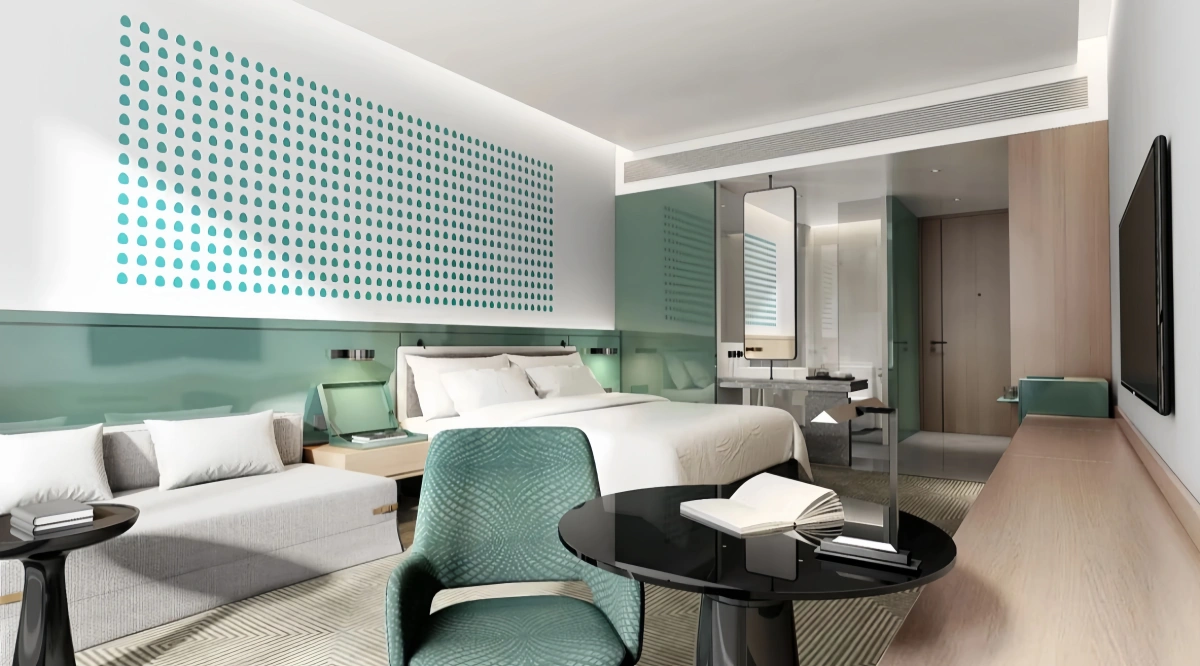
- Minimalist palette with soft mint tones creates a calm, contemporary atmosphere
- Compact table and modular chair support both work and leisure
- Built-in side tables and integrated lighting maximize usability
- Sleek lines and reflective surfaces visually expand the space
Organic Shapes and Soothing Tones Define Modern Luxury
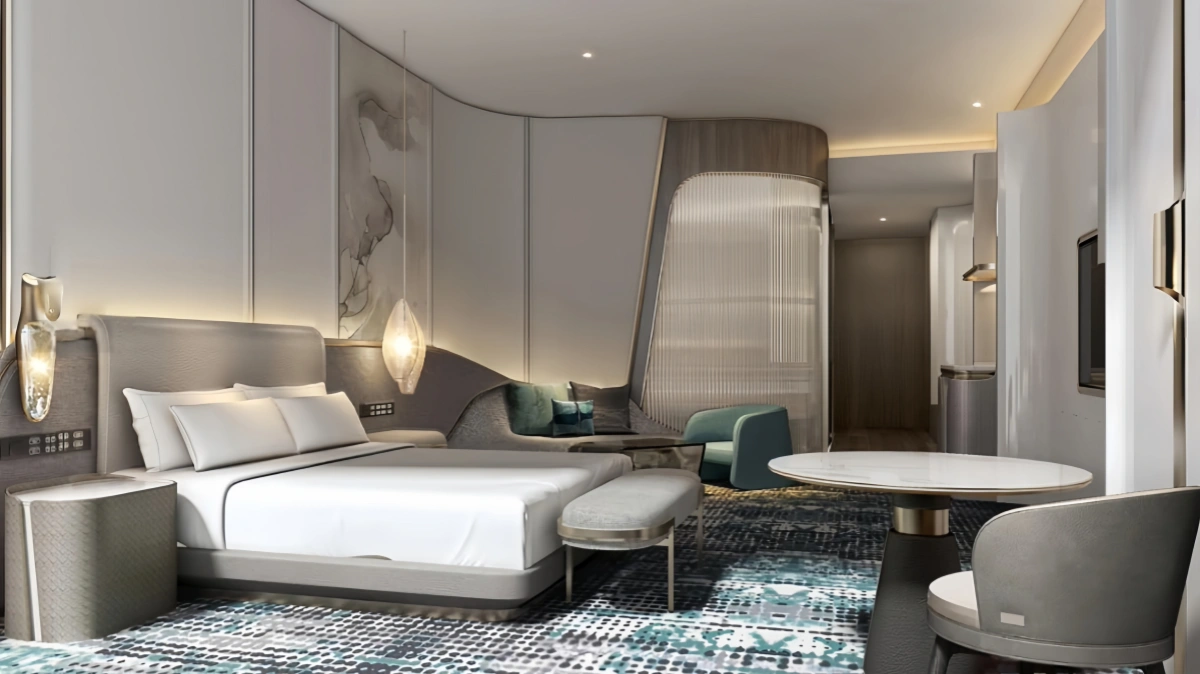
- Curved headboards and lounge seating enhance visual flow and relaxation
- Layered lighting—from pendant lamps to concealed LEDs—creates warmth and depth
- Gentle neutrals mixed with sea-glass tones deliver a serene, upscale feel
- Textured upholstery and tactile surfaces add sensory richness
- Subtle built-ins keep the room uncluttered yet functional
Blending Art, Function, and Luxury Materials
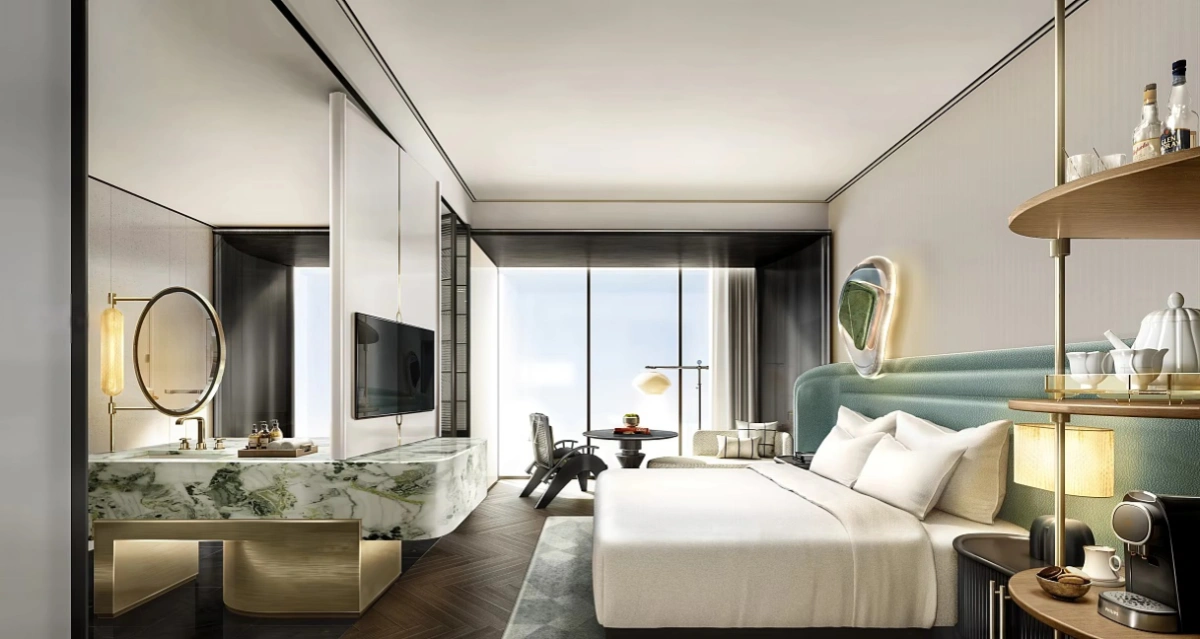
- Integrated furniture pieces (like the marble vanity and media wall) maximize efficiency
- Brushed metal accents introduce understated sophistication
- Pastel upholstery softens the luxurious materials for comfort and warmth
- Open layouts enhance spatial flow between sleep, work, and refresh zones
- Ambient lighting highlights the textures and materials, adding visual drama
Artistic Expression Meets Functional Comfort
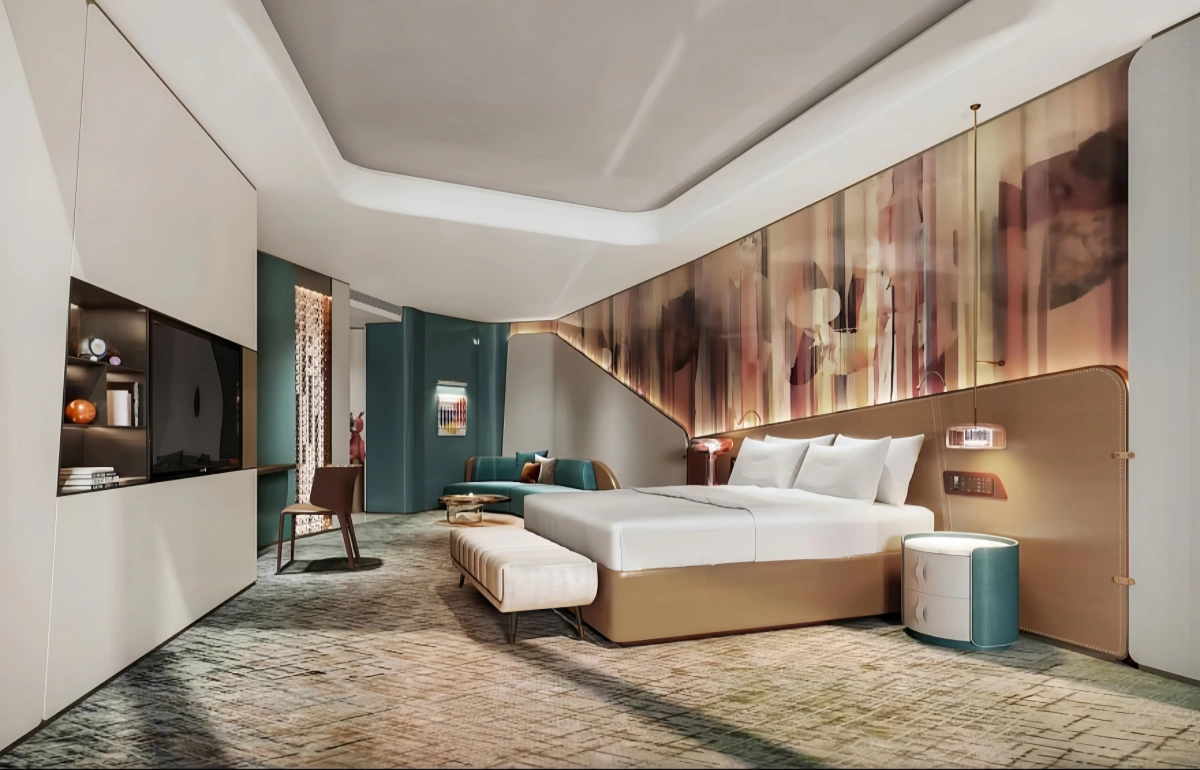
- Abstract wall art acts as the visual centerpiece, giving the room a curated identity
- Integrated lighting enhances the art and mood without overwhelming the space
- Sculptural furniture pieces (bench, lounge chair, coffee table) add visual rhythm
- Warm tones and teal accents balance creativity with comfort
- Flexible zones—sleep, work, and relaxation—flow organically together
Layered Colors and Mixed Materials for a Bold Yet Balanced Look
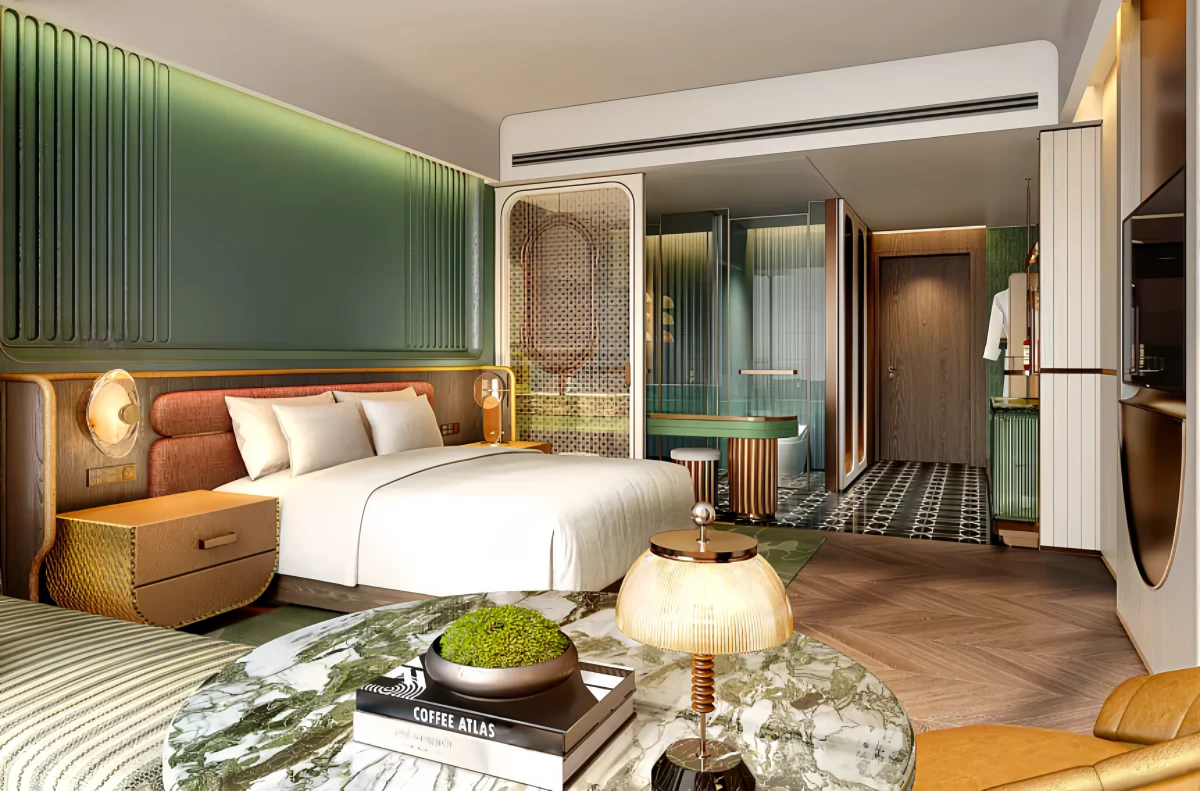
- Emerald green, copper, and tan tones deliver depth and vibrancy
- Leather-wrapped nightstands, fluted wood panels, and marble tables add tactile sophistication
- Metallic details in lighting and trim introduce subtle glamour
- Textural diversity enhances both visual and emotional comfort
- Open glass partitions maintain a sense of flow between sleeping and bathing zones
Modern Heritage – Where Vintage Character Meets Contemporary Comfort
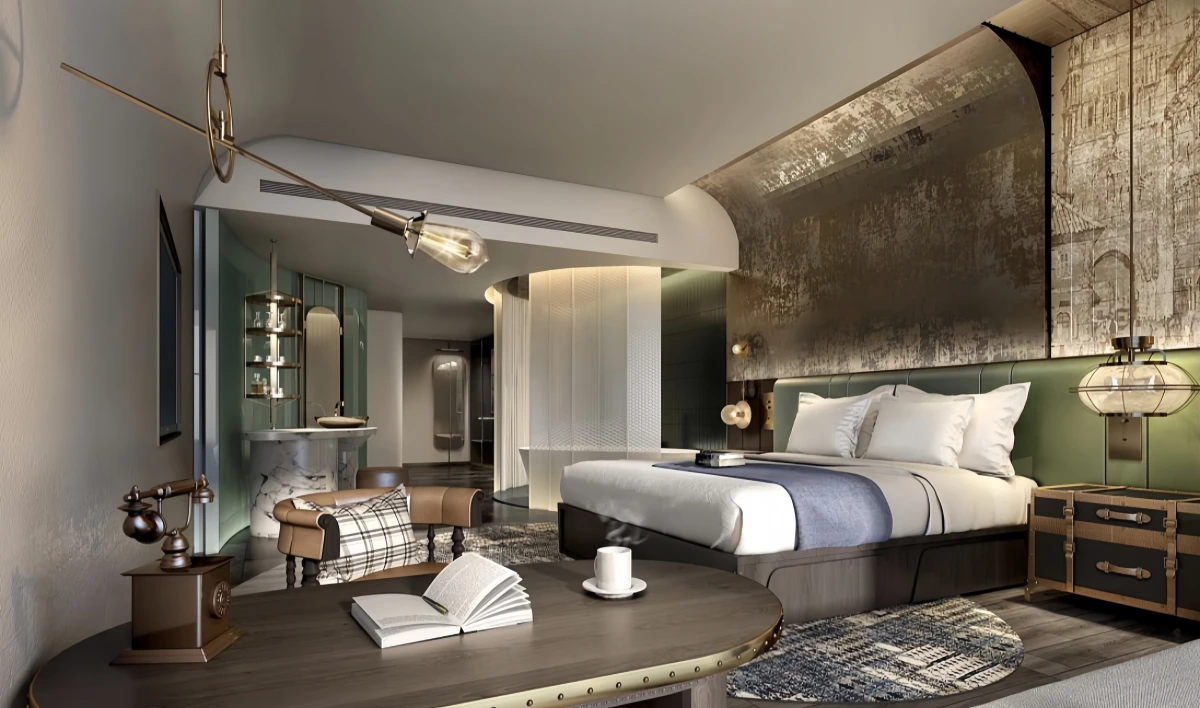
- Aged metallic finishes and textured wall panels create visual drama
- Leather and brass accents nod to classic craftsmanship
- Rounded furniture edges and layered lighting soften the industrial tone
- Built-in modern conveniences—USB ports, reading lights, tech panels—blend seamlessly into the nostalgic aesthetic
- Subtle color layering (olive, bronze, charcoal) adds warmth and timeless appeal
Minimalist Luxury – Where Simplicity Meets Serenity
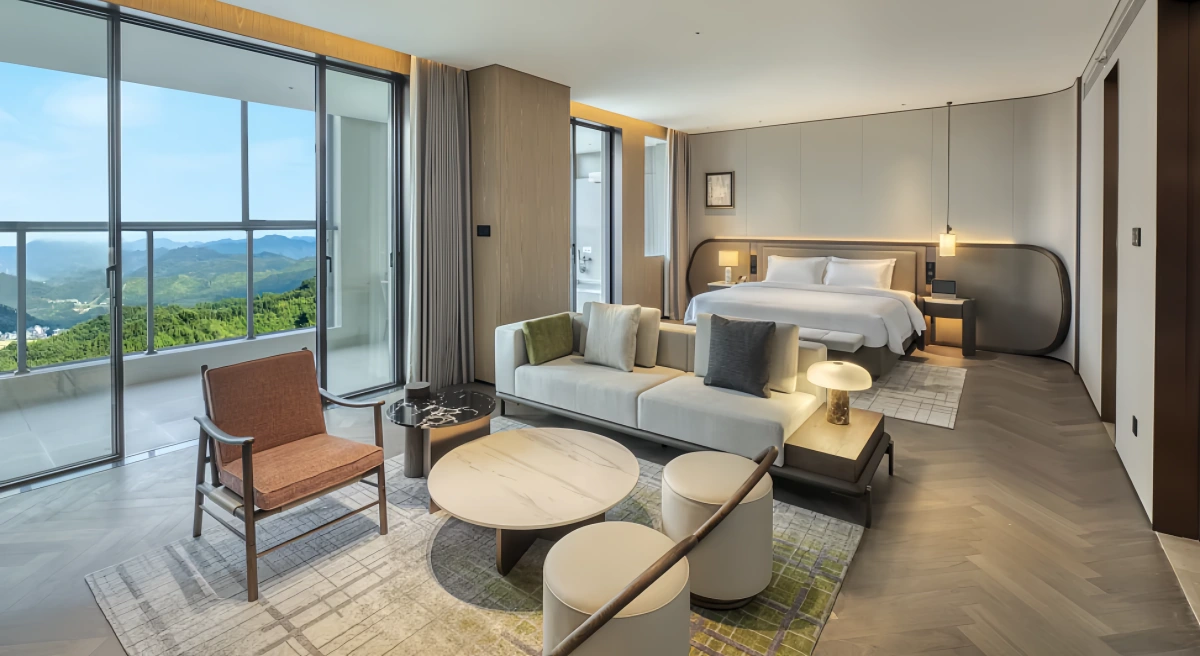
- Neutral tones and wood finishes create a warm, grounding atmosphere
- Low-profile furniture enhances openness and spatial harmony
- A modular sofa and compact tables maximize flexibility without clutter
- Large windows connect the interior with stunning outdoor scenery
- Hidden lighting details add softness and elevate the overall mood
Warm Modernism – Comfort Elevated Through Light and Tone
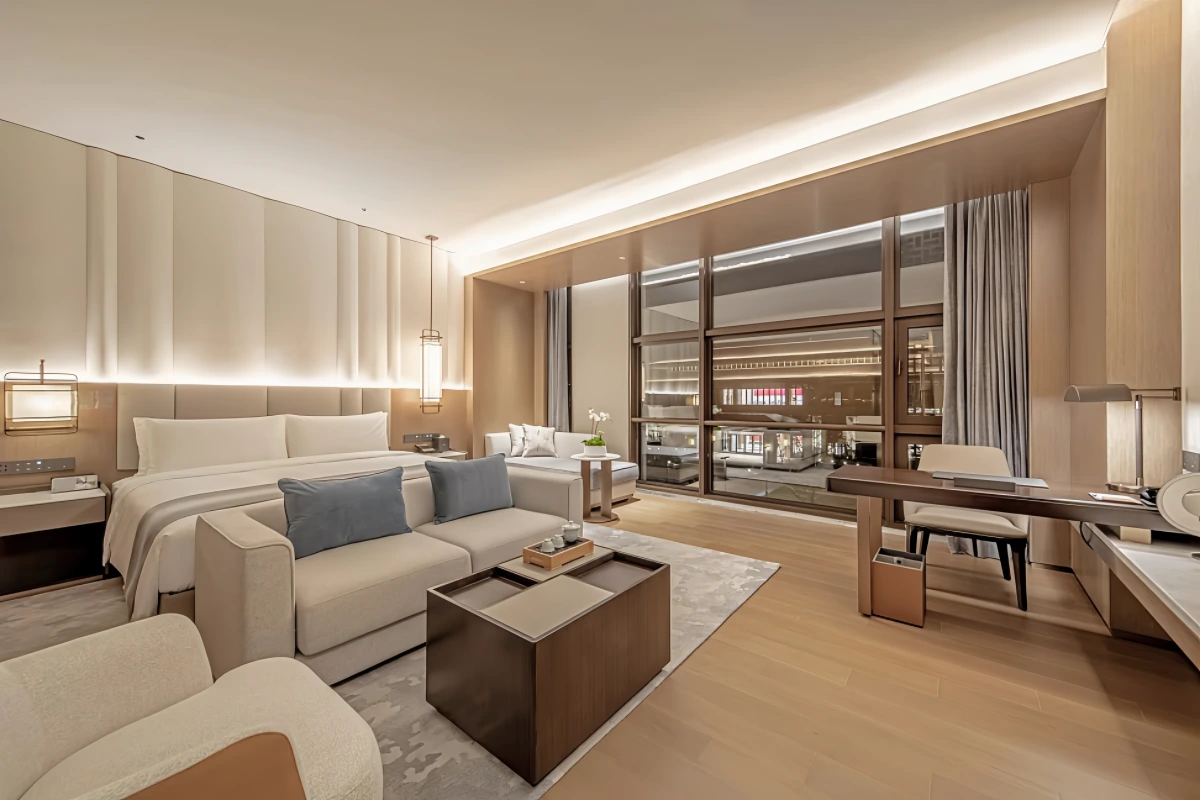
- Neutral palettes of beige, taupe, and soft blue promote relaxation
- Light wood tones and fabric upholstery add visual warmth
- Ambient cove lighting defines architectural rhythm and atmosphere
- Integrated sofa and work area ensure seamless function in limited space
- Minimal metal accents introduce refinement without disrupting softness
Contemporary Asian Simplicity – Calm, Culture, and Clarity
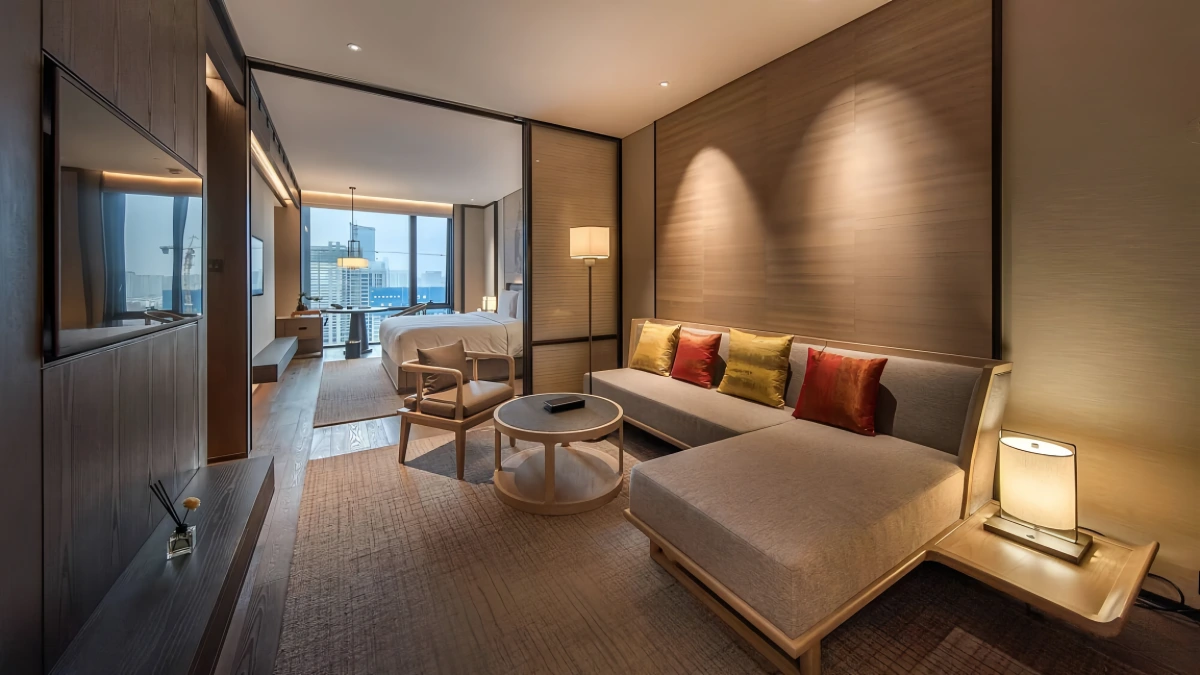
- Light oak wood tones and soft textiles create a serene, meditative mood
- Low-profile furniture encourages open sightlines and breathing space
- Subtle craftsmanship—rounded edges, joinery details—reflect artisanal care
- Pops of muted color through cushions or art add modern vibrancy
- Sliding partitions enable flexible use between bedroom and lounge areas
Coastal Modern Retreat – Minimal Design with a Sense of Escape
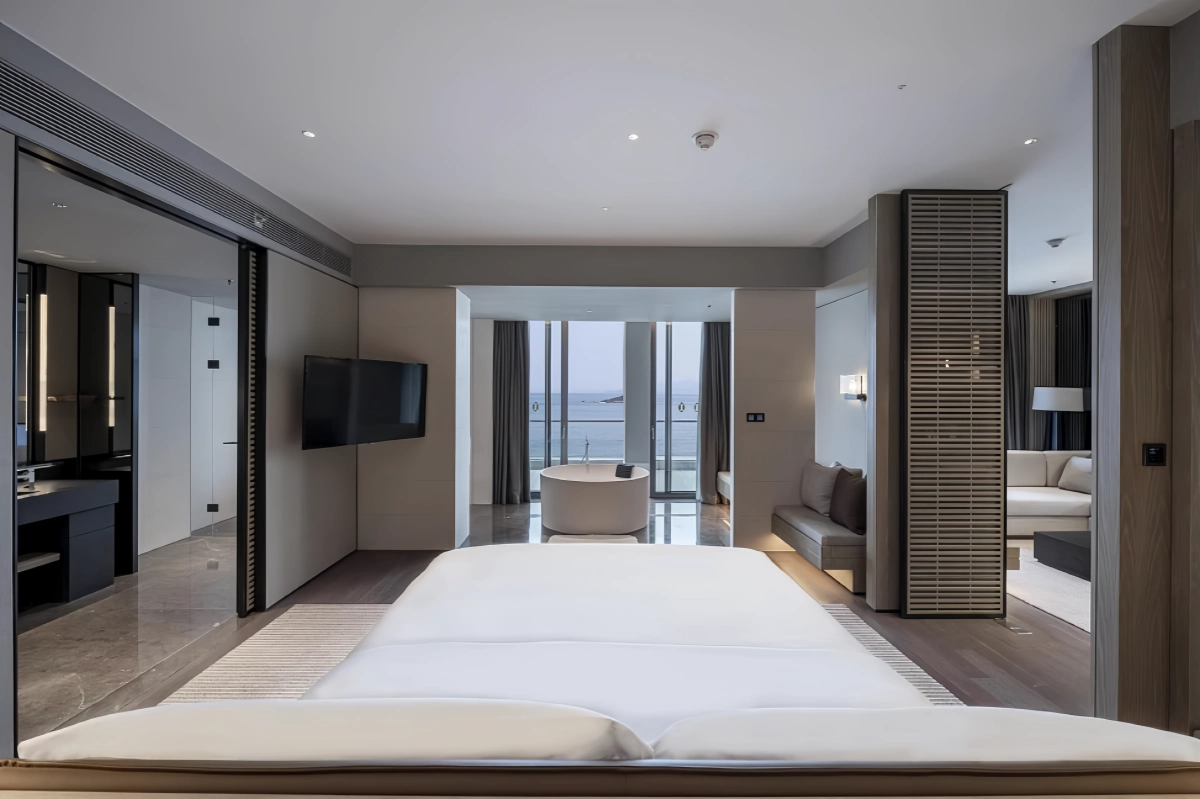
- Clean architectural lines emphasize the ocean view as the focal point
- A freestanding bathtub becomes a sculptural centerpiece—luxury redefined
- Neutral stone and wood finishes echo the natural surroundings
- Low, horizontal furniture enhances the openness and visual calm
- Integrated seating areas create zones for relaxation without clutter
Minimal Luxury with Organic Flow – Simplicity that Breathes
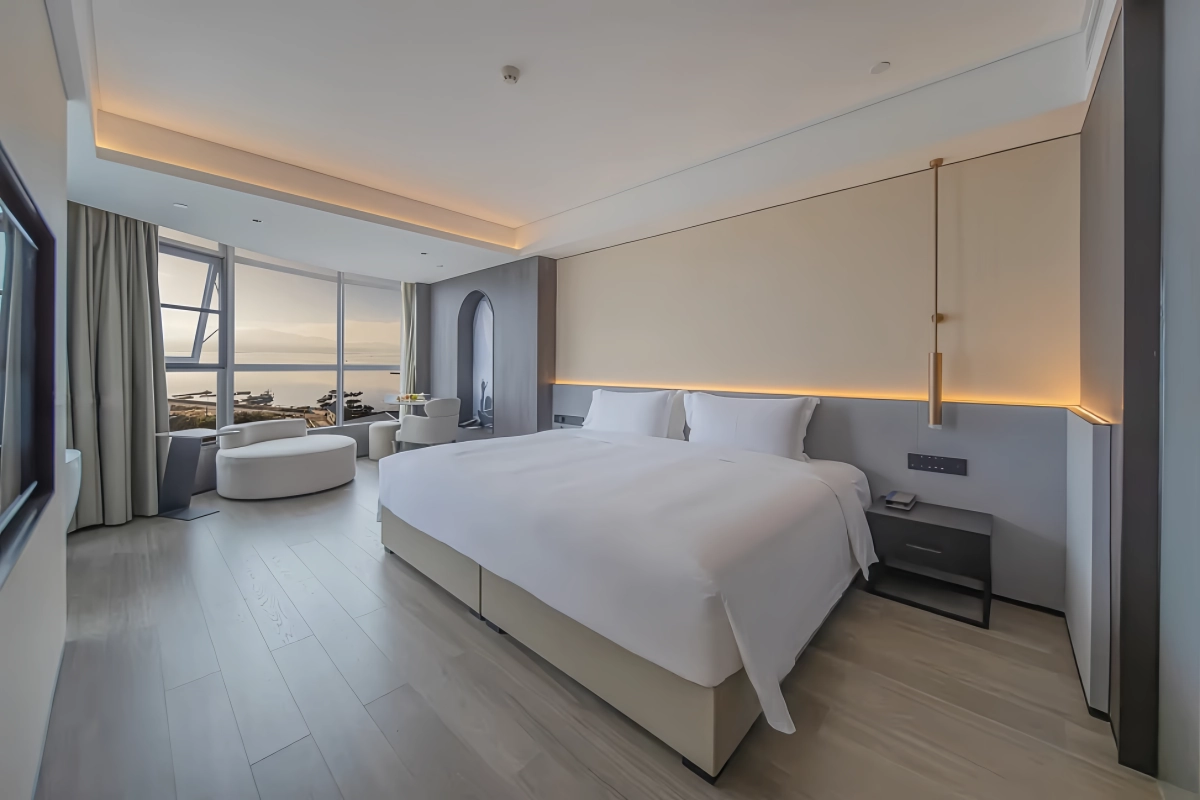
- Neutral tones and seamless finishes reflect quiet sophistication
- Curved furniture edges soften the geometry of the space
- Ambient lighting integrated behind panels enhances depth and warmth
- Minimal yet comfortable seating supports relaxed lounging or contemplation
- Panoramic windows extend the visual horizon, blending interior with landscape
Nature-Inspired Serenity – Bringing the Outdoors In
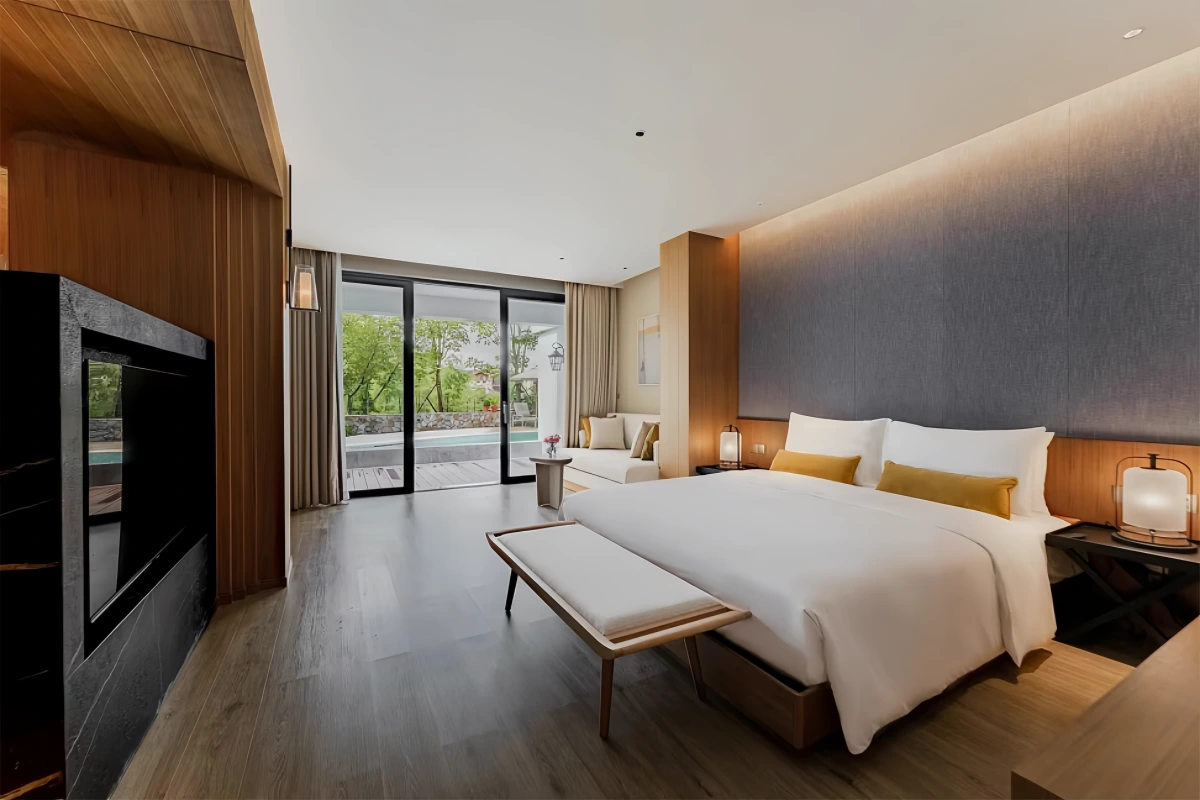
- Wood paneling and soft fabrics add tactile warmth and connection to nature
- Large sliding glass doors blur the boundary between indoor and outdoor living
- Muted color palette—earth, beige, and forest tones—evokes calm and clarity
- Simple, handcrafted furniture emphasizes function and authenticity
- Subtle lighting enhances the natural grain and depth of materials
Conclusion: How These Trends Are Redefining Guest Room Furniture Design
The guest room of 2026 is more than a space to stay—it’s an ecosystem of comfort, emotion, and function. Across these 12 design directions, a few universal themes emerge: personalization, emotional balance, and the seamless integration of technology and nature.
Tomorrow’s hotel rooms no longer chase grandeur; they pursue meaning. Every furniture choice—from the curvature of a headboard to the tactility of a bedside lamp—is intentional, designed to calm, inspire, and adapt. The best spaces are those that invite guests to feel at home while discovering something new.
What defines the future of guest room design is not opulence, but experience. Whether through modular forms, biophilic materials, or serene minimalism, the new generation of hospitality furniture creates a dialogue between aesthetics and atmosphere—between how a space looks, and how it makes you feel.
Sustainable Hotel Furniture Trends 2026
Sustainability is no longer a buzzword—it’s the foundation of modern hospitality design. In 2026, hotel guest room furniture is being reimagined with eco-conscious materials, circular design principles, and energy-efficient production. Hotels are realizing that sustainability not only reduces environmental impact but also strengthens brand trust and guest loyalty.
Today’s travelers, especially younger generations, actively prefer hotels that make visible efforts toward responsible design. That means every furniture decision—from sourcing to disposal—can become a sustainability statement.
1. Eco-Friendly Materials with High Aesthetic Value
- Certified woods (FSC, PEFC) from responsibly managed forests
- Recycled metals and plastics re-engineered for durability
- Bamboo and rattan for lightweight, fast-renewing alternatives
- Low-VOC finishes and water-based paints to improve indoor air quality
2. Furniture Built for Longevity and Repair
- Modular construction enables part replacement instead of full disposal
- Detachable upholstery and reconfigurable components extend product life
- Durable hardware minimizes breakage during heavy hotel use
3. Circular Manufacturing & Take-Back Programs
- Take-back programs retrieve old furniture for refurbishment
- Recycled materials from retired pieces are reintroduced into new production
- Component tracking ensures full traceability for future disassembly
4. Local Sourcing for Lower Carbon Footprint
- Supports local artisans and small manufacturers
- Cuts freight-related carbon emissions
- Simplifies maintenance and reordering
5. Smart Sustainability: Tracking & Transparency
- QR codes linking to furniture lifecycle data
- CO₂ footprint displayed in procurement dashboards
- Integration with LEED, BREEAM, or WELL certification frameworks
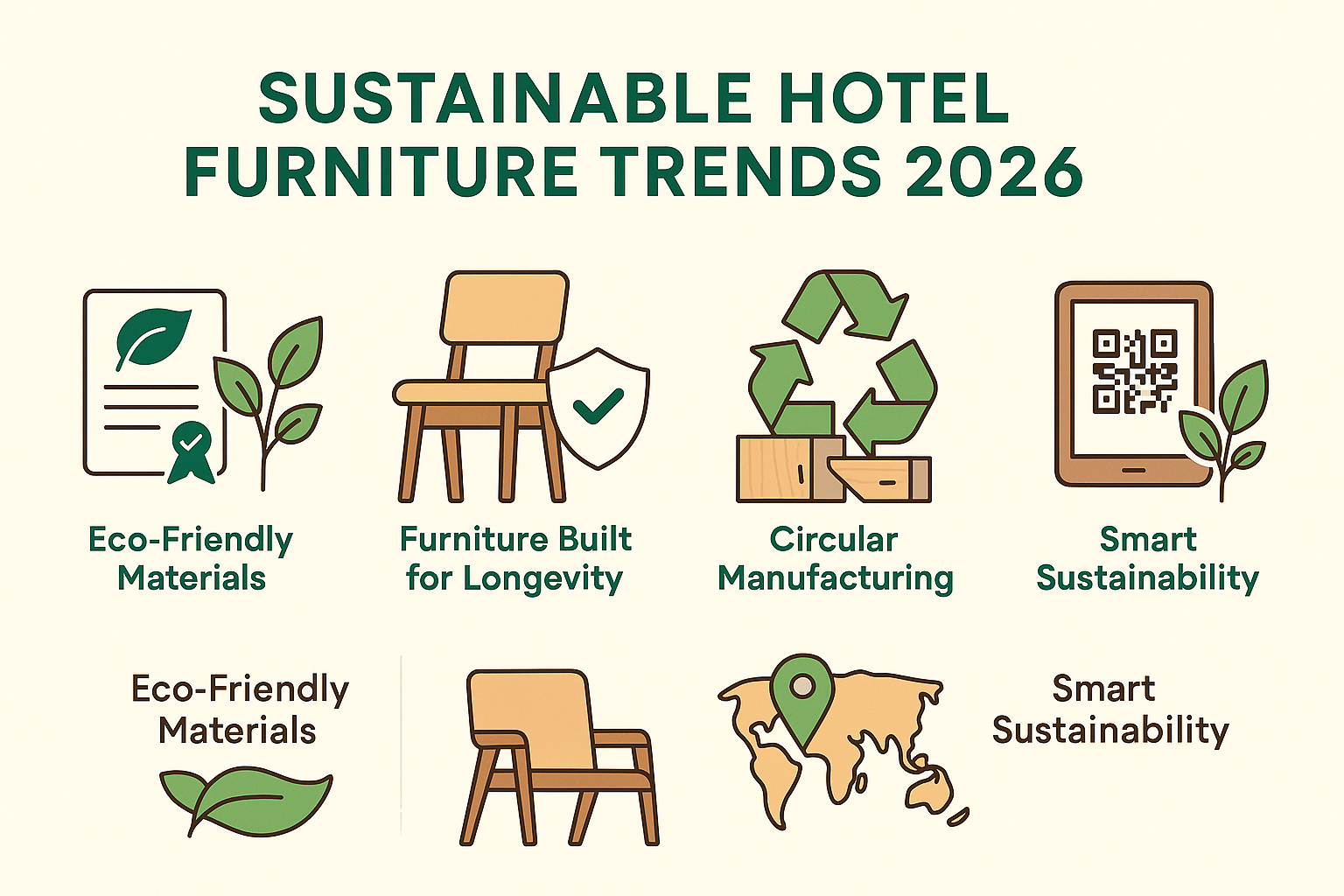
Where to Buy Hotel Guest Room Furniture (With Supplier Examples)
In 2026, sourcing hotel guest room furniture is no longer just a procurement task—it’s a strategic design decision. The right supplier defines your project’s quality, delivery speed, and even how guests perceive your brand.
Today’s market offers several sourcing channels—from local factories to global OEM partners—and each fits a different project scale, budget, and brand requirement. Below is a practical overview to help you choose wisely.
1. Local and Regional Manufacturers
- Shorter lead times and reduced freight costs
- Easier quality control through on-site visits
- Ability to adapt designs for regional tastes and climate
2. International Hospitality Furniture Suppliers
Bryan Ashley (USA) – Renowned for custom casegoods and seating for global hotel brands.
Curtis Furniture (UK) – Trusted partner for design-led hotel projects with turnkey manufacturing.
Yabo Furniture (China) – Supplies luxury hotels such as Hilton and Marriott, specializing in high-end wood and upholstered furniture.
3. OEM & ODM Manufacturers in Asia
Censo Home (China) – Offers full custom hotel guest room furniture solutions—from design, prototyping, and production to export and installation. Ideal for projects seeking flexibility, premium materials, and brand-driven design.
Trinity Furniture (China) – Known for efficient project management and contract-grade finishes.
Sunlink Furniture (China) – Specializes in modular guest room collections with fast production capacity.
- Customization without luxury pricing
- Integrated production and global shipping
- Access to innovative materials and manufacturing technology
4. Design-Build Partnerships
- One point of contact = fewer errors and delays
- Unified aesthetic vision from design to delivery
- Simplified project management and warranty support
Censo Home’s Design + Manufacture Model has gained attention from international design firms for its seamless workflow and global export experience. This approach ensures consistency in color, material, and detailing across every guest room.
Conclusion: The Future of Hotel Guest Room Furniture Design
Designing a hotel guest room in 2026 is no longer just about aesthetics — it’s about creating spaces that blend comfort, efficiency, and brand storytelling. The best furniture doesn’t just fill a room; it enhances how guests rest, work, and feel. Every material, layout, and detail contributes to an experience that is both functional and emotionally engaging.
As hotel brands evolve, the demand for custom-made guest room furniture continues to grow. Custom design allows hotels to express their identity, optimize space, and ensure long-term value through quality craftsmanship. By partnering with a trusted hospitality furniture manufacturer like Censo Home, hoteliers can achieve the perfect balance between design vision, operational practicality, and guest satisfaction — building rooms that feel timeless, memorable, and unmistakably unique.

